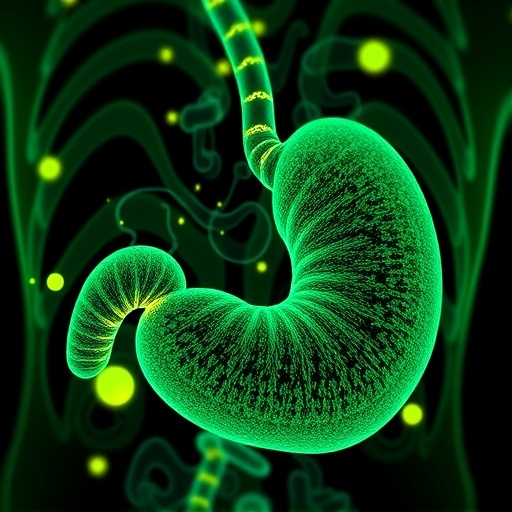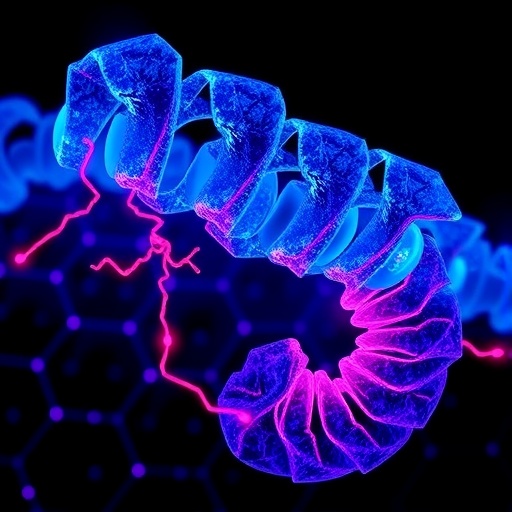In an intriguing advancement in cancer treatment, a recent study led by Kudo-Saito and collaborators highlights the importance of the IL33-ST2 axis as a predictive biomarker for the efficacy of anti-PD1 therapies in advanced gastric cancer. Gastric cancer presents one of the most significant challenges in oncology, warranting continual research to unveil more effective therapeutic options. The research underscores how understanding these molecular interactions can lead to improved outcomes for patients suffering from this aggressive disease, offering hope where conventional treatment approaches may falter.
The study meticulously investigates the complex interplay between interleukin-33 (IL-33) and its receptor ST2, which has emerged as a critical factor in mediating immune responses. IL-33 is a member of the IL-1 cytokine family, primarily known for its role in promoting type 2 immune responses. However, its function extends into the realm of cancer biology, suggesting that it can manipulate the tumor microenvironment in ways that potentially enhance or inhibit cancer progression. This discovery is pivotal because it paints a more nuanced picture of how inflammatory cytokines like IL-33 contribute to the cancer landscape.
Among the therapies available for advanced gastric cancer, anti-PD1 treatments have gained considerable traction. PD-1, or programmed cell death protein 1, is a checkpoint protein on T cells that, when engaged, can inhibit immune responses against tumor cells. By blocking this interaction with antibodies, anti-PD1 therapies aim to reactivate the body’s immune system to recognize and attack cancer cells. However, the response to these therapies is variable among patients, underscoring the need for biomarkers that can predict treatment efficacy.
The research conducted by Kudo-Saito et al. unravels the connection between the IL33-ST2 axis and the predictive potential for anti-PD1 therapy effectiveness. They conducted a series of experiments using patient-derived samples and animal models, establishing a correlation between high IL-33 levels and enhanced responsiveness to anti-PD1 treatment. This correlation provides a compelling rationale for further exploration into the IL33-ST2 axis as a stratification tool for patient selection in clinical settings, enabling more personalized approaches to cancer therapy.
One of the fascinating aspects of this research is the methodical approach employed to analyze the expression levels of IL-33 and ST2 in gastric cancer samples. Utilizing advanced immunohistochemistry techniques, researchers were able to visualize and quantify the distribution of these proteins within tumor tissues. The results consistently indicated that tumors expressing high IL-33 levels exhibited significant infiltration of CD8+ T cells, correlating with a favorable response to anti-PD1 therapies.
The team also explored the potential underlying mechanisms that may govern this relationship. It was identified that IL-33 can induce the expression of various chemokines and cytokines that may enhance T cell recruitment and activation within the tumor microenvironment. This is particularly important as the functional state of T cells can greatly influence the success of immunotherapy; hence, the IL33-ST2 axis may serve as a crucial regulatory pathway that can be targeted to boost therapeutic efficacy.
While the findings are compelling, they also raise important questions regarding the heterogeneity of gastric cancer. The different subtypes and molecular characteristics of gastric tumors can complicate treatment choices. The research demonstrates the significant role that the IL33-ST2 axis plays across these subtypes, hinting at its potential universal application as a biomarker. However, further studies are warranted to fully understand the dynamics of this relationship in various gastric cancer backgrounds, which may help tailor more effective treatment regimens.
The implications of this research extend beyond merely enhancing our understanding of gastric cancer biology. Identifying biomarkers such as the IL33-ST2 axis helps clinicians make more informed decisions, potentially leading to improved prognosis and management strategies. Personalized medicine hinges on the ability to predict responses based on individual patient characteristics, and studies like this propel the field toward that goal.
In light of the ongoing evolution of cancer therapies, integrating biomarker assessments into routine clinical practice is becoming increasingly feasible. The study’s findings encourage oncologists to consider the IL33-ST2 axis when evaluating treatment options for advanced gastric cancer patients, thus potentially improving response rates and patient outcomes. As the landscape of cancer treatment continues to shift towards precision medicine, research that links biomarkers with therapeutic efficacy is paramount.
The researchers aim to translate their findings into clinical protocols, paving the way for future investigations that can validate the IL33-ST2 axis’s role in diverse settings. This includes conducting larger cohort studies to confirm the association across larger populations and differing demographics. Furthermore, exploratory trials that manipulate the IL33-ST2 axis directly could uncover novel therapeutic strategies to enhance the efficacy of existing treatments.
It is vital to engage with the research community to discuss these findings and their implications thoroughly. Interdisciplinary collaborations between oncologists, immunologists, and researchers could foster innovative approaches to leverage the IL33-ST2 axis in clinical oncology settings. Furthermore, disseminating this information through conferences and publications will promote awareness and potentially catalyze further interest in the role of cytokines in cancer treatment.
Ultimately, these advancements herald a new era in advanced gastric cancer treatment, focusing on patient-centered care and tailored therapeutic strategies. As ongoing research elucidates the intricate connections between immune pathways and tumor biology, the hope is to redefine the standards of care, achieving higher efficacy and fewer side effects for patients battling this formidable disease.
This compelling investigation into the IL33-ST2 axis serves as a clarion call for the cancer research community. The future of oncology may well hinge on understanding and manipulating the body’s immune responses, with studies like this unlocking new strategies to combat advanced gastric cancer and potentially other malignancies. The continuous exploration of these pathways is essential not only for improving current treatments but also for paving the way for novel therapeutic interventions that can offer hope in the face of one of today’s most challenging health crises.
Subject of Research: Advanced Gastric Cancer and Immune Response
Article Title: IL33-ST2 axis is a predictive biomarker for anti-PD1 therapeutic efficacy in advanced gastric cancer.
Article References:
Kudo-Saito, C., Imazeki, H., Nagashima, K. et al. IL33-ST2 axis is a predictive biomarker for anti-PD1 therapeutic efficacy in advanced gastric cancer.
J Transl Med 23, 1125 (2025). https://doi.org/10.1186/s12967-025-07145-3
Image Credits: AI Generated
DOI:
Keywords: IL33-ST2 axis, anti-PD1 therapy, gastric cancer, biomarkers, oncology, immunotherapy, precision medicine, T cell response.
Tags: advanced gastric cancer treatmentanti-PD1 efficacy in gastric cancercancer immunotherapy advancementscytokines in tumor microenvironmentIL33-ST2 axisimmune response and cancer progressioninflammatory cytokines and cancer landscape.interleukin-33 role in oncologymolecular interactions in cancer treatmentPD-1 checkpoint inhibitorspredictive biomarker for cancer therapytherapeutic options for gastric cancer





